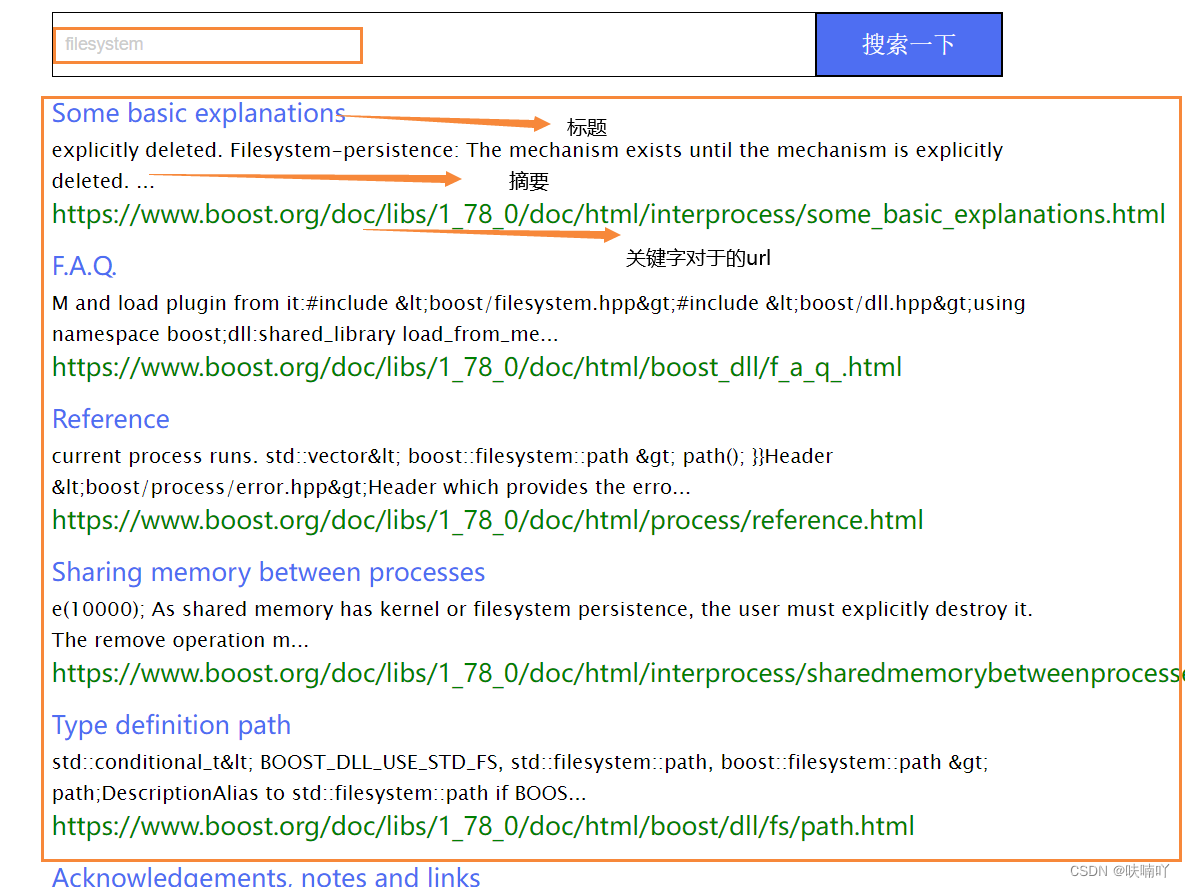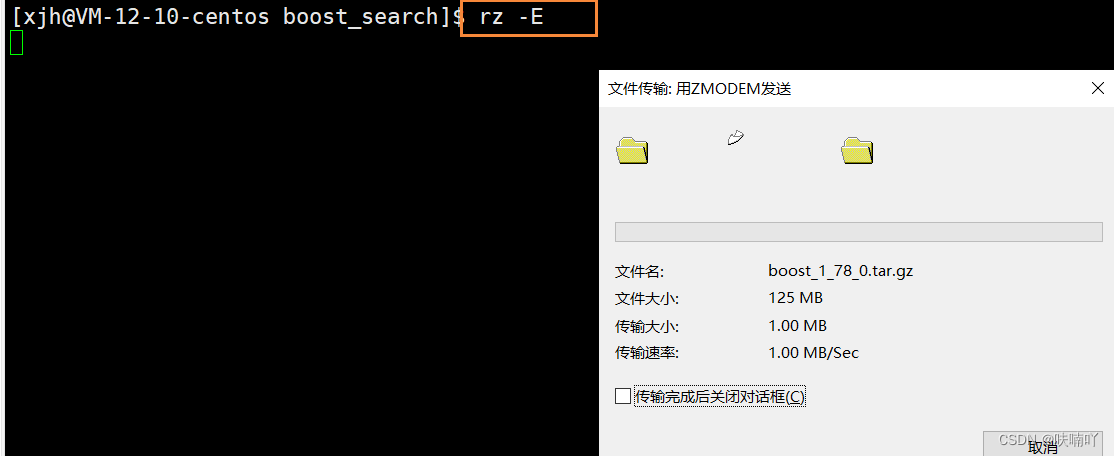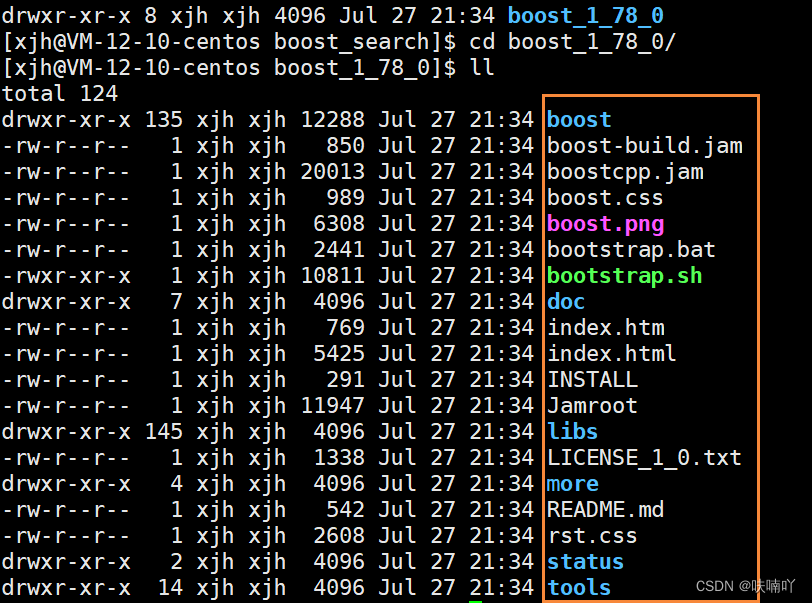文章目录
项目的gitee地址
项目地址,复制到浏览器打开:
https://gitee.com/xiao-jiheng/boost_search_engine
项目基本演示
主要是:服务端开启服务,客户端就可以通过浏览器进入页面进行搜索服务,搜索的内容就是
BOOST库的内容;
项目的基本目录:

启动项目的过程命令;
[xjh@VM-12-10-centos boost_searcher]$ make #对整个项目进行编译
[xjh@VM-12-10-centos boost_searcher]$ ./parser #编译成功对网页进行去标签
[xjh@VM-12-10-centos boost_searcher]$ ./http_server #启动服务器
去标签目的:是对网页内容进行清洗,因为我们搜索的内容不是需要网页标签,所以需要去掉;
启动服务:服务端要提供网页资源供用户搜索,该网页资源需要构建索引;
如何验证是否启动服务器成功?
[xjh@VM-12-10-centos boost_searcher]$ netstat -nltp#查看网络状态

用户需要提供搜索关键字进行搜索;搜索页面如下:
默认使用端口为8081;

搜索结果大概如下:

点击任何一条链接:肯定会包含我们搜索关键字;
讲解思路
- 项目的相关背景
- 搜索引擎的相关宏观原理
- 搜索引擎技术栈和项目环境
- 正排索引 vs倒排索引–搜索引擎具体原理
- 编写数据去标签与数据清洗的模块Parser
- 编写建立索引的模块Index
- 编写搜索引擎模块Searcher
- 编写http_server模块
- 编写前端模块
一:项目相关背景
- 公司:百度、搜狗、360搜索、头条新闻客户端 - 我们自己实现是不可能的!
技术门槛高,保存海量的网络资源就是一个问题了;
更别说根据客户的关键字,对关键字排序,显示网页内容的工作; - 站内搜索:搜索的数据更垂直,数据量其实更小;
- boost的官网是没有站内搜索的,需要我们自己做一个;
我们写的是一个站内搜索,就是搜索资源就是boost库的内容!
展示内容就是:标题;网页内容的摘要,和url 这三个关键的信息;
并且点击内容可以跳转相关的网站
不像百度的,既有图片,还有视频,还有广告等内容,甚至对关键字搞了标红了;
我们的站内搜索仅仅是利用了搜索引擎的基本原理去完成的;

二:搜索引擎的相关宏观原理
首先服务器:
内部是提前准备好要搜索的资源的,该资源是通过爬虫程序爬取网络的信息,然后保存在自己服务器上的磁盘;
然后对爬取到的网页内容进行数据清晰工作,去掉标签,保留主要关键信息;
同时对爬取的内容进行建立索引,目的为了用户方便查找服务器资源,加快用户查找效率;
对于客户端,也就是浏览器,要通过GET请求方式上传自己的关键字,服务器收到后,就会对请求报文进行处理,检索关键字,得到相关资源,构建相关资源的html信息返回给用户!

三:搜索引擎技术栈和项目环境
- 技术栈: C/C++ C++11, STL, 准标准库Boost,Jsoncpp,cppjieba,cpp-httplib ;
- html5, css,js、jQuery、Ajax(本项目前端技术的基本很少使用,主要在后端)
- 项目环境: Centos 7云服务器,vim/gcc(g++)/Makefile , vs code
cppjieba: 分词工具,主要对用户搜索关键字进行切分,切分搜索,并且返回切分搜索到的结果;同时服务器建立索引时候,也需要对关键字进行切分;
cpp-httplib:直接构建服务器的开源库;
四:正排索引 vs 倒排索引 - 搜索引擎具体原理
正排和倒排索引文章链接(直接点击就可以跳转网页资源)
上面那文章是网络搜索的,对正排倒排的解释;我自己也会解释一下,但是是简单说明!不是具体解释概念;
我所将的是正排倒排的特点,及其在搜索引擎承担什么角色任务!
正排索引:文档id和文档内容的映射关系;就是通过文档id去找到文档内容(也有人说是找到文档内的关键字);
以后我们搜索肯定是根据关键字进行搜索文档内容的;
所以我们服务器必须对文档内容进行分词,分词目的就是为了方便建立倒排索引;
分词:
文档1[雷军买了四斤小米 ]: 雷军/买/四斤/小米/四斤小米;
文档2[雷军发布了小米手机]:雷军/发布/小米/小米手机;
这里文档1 分词就是分为了这几个部分 [雷军] [买] [四斤] [小米] [四斤小米] (举个例子这里,分词的策略有很多种的);
我们就是通过这些分词结果对其进行倒排索引建立,方便用户更具关键字查找到内容;

模拟一次查找的过程:
用户输入:小米 -> 倒排索引中查找 -> 提取出文档ID(1,2) -> 根据正排索引 -> 找到文档的内容 ->
title+conent(desc)+url 文档结果进行摘要->构建响应结果;
注意:编写代码时候,我们需要构建倒排索引,构建倒排索引需要文档内容进行分词,用分词结果去构建倒排索引;
然后用户搜索时候,我们也需要对用户搜索关键字进行分词,根据分词,也即是关键字,去倒排索引找到关键字对应文档ID,再拿到文档ID去正排索引找到文档内容!
五:编写数据去标签与数据清洗的模块 Parser
先下boost库的资源到Linux中,让其作为服务器搜索资源;
boost 官网: https://www.boost.org/
//目前只需要boost_1_78_0/doc/html目录下的html文件,用它来进行建立索引
进入官网:找到该图标

点击下载该版本的到你的桌面(当然下载哪个版本都无所谓,只是我的boost版本就是该版本);

使用命令:
[xjh@VM-12-10-centos boost_search]$ rz -E #把桌面的boost库传到Linux中;

成功对齐解压即可:
tar -zxvf boost_1_78_0.tar.gz #解压即可
这就是boost库的官网的内容!

但是我们进行站内搜索的内容:只是使用该路径的资源:
boost_1_78_0/doc/html/
里面包含boost库的所有内容!也就是该项目可以被搜索到的资源
将该文件内容拷贝到data/input目录,也就是我们boost搜素引擎的搜索内容

后序工作就是拿到data/input的内容,构建索引!
创建一个parser.cc文件的主要功能就是去标签的任务!

把去标签的内容保存再 raw.txt文档内容

目标:把每个data\input下的文档都去标签,然后写入到同一个raw.txt文件中!
每个文档内容不需要任何\n!文档和文档之间用 \3 区分;
XXXXXXXXXXXXXXXXX\3YYYYYYYYYYYYYYYYYYYYY\3ZZZZZZZZZZZZZZZZZZZZZZZZZ\3;
选择\3原因:它是不可显示字符,不会污染我们的数据源!
5.1 parser基本代码结构
该代码是在 文件 parser.cc,的基本结构;
该文件的主要完成功能是:对所有要搜索的boost资源html文档,进行数据清洗工作;
步骤:
- 读取所有的该路径下
const std::string src_path = "data/input";所有的html文档的名称到一个数组中保存vector<std::string> &files_list; - 读取每一个html文档,也就是枚举数组
vector<std::string> &files_list的每一个元素,对其进行去标签的,获取标题,文档内容,和url 三个主要的信息存储在std::vector<DocInfo_t> results;数组中; - 将去标签的html文档信息从数组
std::vector<DocInfo_t> results读取兵保存到在const std::string output = "data/raw_html/raw.txt";文档中;
#include <iostream>
#include <string>
#include <vector>
#include <boost/filesystem.hpp>
#include <fstream>
#include "util.hpp"
const std::string src_path = "data/input";
const std::string output = "data/raw_html/raw.txt";
typedef struct DoInfo
{
std::string title; //文档的标题
std::string content; //文档的内容
std::string url; //文档在官网url
} DocInfo_t;
//函数参数命名规范小细节;
/*
* const& :输入参数
* * :输出参数
* & :输入输出参数
* */
bool EnumFile(const std::string &src_path, std::vector<std::string> *files_list);
bool ParseHtml(const std::vector<std::string> &files_list, std::vector<DocInfo_t> *results);
bool SaveHtml(const std::vector<DocInfo_t> &results, const std::string &output);
int main()
{
std::vector<std::string> files_list; //保存 src_path路径下所有的html文件名
// 1.递归式的把src_path路径下的所有文件名(带路径的)保存在files_list,目的方便后期读取
if (!EnumFile(src_path, &files_list))
{
std::cerr << "enum file name error" << std::endl;
return 1;
}
// 2.对每个文件html文件进行读取其内容,并解析出结果存放在DocInfo结构体中
std::vector<DocInfo_t> results;
if (!ParseHtml(files_list, &results))
{
std::cerr << "parse html error" << std::endl;
return 2;
}
// 3.将解析到的各个文档的DocInfo信息存放到output文件中,并通过\3作为每个文档解析结果进行分割
if (!SaveHtml(results, output))
{
std::cerr << "save html error" << std::endl;
return 3;
}
return 0;
}
5.2 使用boost库函数枚举每个html文件名
有了5.1小节的基本结构parser.cc文件清洗数据基本结构,接下来就完成每一步的细节;
5.2小节就是完成bool EnumFile(const std::string &src_path, std::vector<std::string> *files_list);该函数的;
该函数的功能就是:枚举src_path路径下的所有文件,并把读取的.html文件名结尾的文件保存在files_list当中;
说白了就是该路径以html结尾的文件,读取到内存中;

该函数的具体实现代码:
bool EnumFile(const std::string &src_path, std::vector<std::string> *files_list)
{
namespace fs = boost::filesystem;
fs::path root_path(src_path); // root_path是开始递归搜索的根目录路径
//判断搜索的文件路径是否是存在
if (!fs::exists(root_path))
{
std::cerr << src_path << " not exists " << std::endl;
return false;
}
//递归遍历root_path
fs::recursive_directory_iterator end; //空迭代器,用来判断递归结束标志
for (fs::recursive_directory_iterator it(root_path); it != end; it++)
{
//遍历的文件:需要拿到的是普通文件,目录和其他文件就不处理
if (!fs::is_regular_file(*it))
continue;
//是普通文件还要判断是否为html文件
if (it->path().extension() != ".html") // extension获取文件名的后缀
continue;
// std::cout << "debug: " << it->path().string() << std::endl;
//来到这里肯定是一个合法以.html结尾的合法文件
files_list->push_back(it->path().string());
}
return true;
}
当然里面使用了很多是boost库提供的函数;我是用的是boost 1.53版本的函数;
5.3 解析html代码编写
当我们获取到html文档的每个文件名,就需要对其每个html文档进行解析;
要解析之前,肯定要根据每个html文档的文件名进行读取html的文档,再对其解析;
解析获取三个信息:标题,内容,url 即可;
该模块主要是完成:bool ParseHtml(const std::vector<std::string> &files_list, std::vector<DocInfo_t> *results);函数的编写;
bool ParseHtml(const std::vector<std::string> &files_list, std::vector<DocInfo_t> *results)
{
for (const std::string &file : files_list)
{
// 1.读取文件名file的内容
std::string result;
if (!ns_util::FileUtil::ReadFile(file, &result))
continue;
DocInfo_t doc;
// 2.解析内容获得title
if (!ParseTitle(result, &doc.title))
continue;
// 3.解析内容获取content
if (!ParseContent(result, &doc.content))
continue;
// 4.解析内容获取url
if (!ParseUrl(file, &doc.url))
continue;
//来到这里说名:解析一个文件内容成功,当前解析结果放在doc中
// results->push_back(doc); //小细节:push_back扩容会发送拷贝,效率低
results->push_back(std::move(doc)); //这个doc内容太大了,并且是临时对象,我们可以直接移动构造很棒,减少拷贝
return true;
}
//*****************************************************//
static bool ParseTitle(const std::string &file, std::string *title)
{
std::size_t begin = file.find("<title>");
if (begin == std::string::npos)
return false;
std::size_t end = file.find("</title>");
if (end == std::string::npos)
return false;
begin += std::string("<title>").size();
if (begin > end)
return false;
*title = file.substr(begin, end - begin);
return true;
}
//参数file是一个html文件的内容(还没被解析的html文件内容)
static bool ParseContent(const std::string &file, std::string *content)
{
//去标签,基于简单的的状态机编写
enum status
{
LABLE, //标签
CONTENT //内容
};
enum status s = LABLE; //默认的所有html网页刚开始的字符串肯定是标签
for (char c : file) //遍历html网页的内容里面的每一个字符
{
//检测状态
switch (s)
{
//当我们读到的是标签,也就是处于LABLE状态,那么我们什么都不做,继续读取下一个
//什么时候该LABLE状态结束呢?当读取到'>'表示LABLE状态结束
case LABLE:
if (c == '>')
s = CONTENT;
break;
//处于CONTENT状态就把读取到的字符假如content,
//什么时候该CONTENT状态结束呢?只要碰到'<'就表示结束了
case CONTENT:
if (c == '<')
s = LABLE;
else
{
//读取到的字符可能有\n,我们不希望保留,因为要做html解析后文本的分隔符
if (c == '\n')
c = ' '; //小细节:源文档的file的\n是没有被修改的,这里遍历file拿到的c字符串不是引用,所以不会修改
content->push_back(c);
}
break;
default:
break;
}
}
return true;
}
//file_path:就是要查询的html文档在我们Linux的 ./data/input/ 目录下的文件路径;
static bool ParseUrl(const std::string &file_path, std::string *url)
{
std::string url_head = "https://www.boost.org/doc/libs/1_78_0/doc/html";
std::string url_tail = file_path.substr(src_path.size());
*url = url_head + url_tail;
return true;
}
该代码的基本四个逻辑:
1. 读取每一个html文档;
2. 解析html的标题;
3. 解析html的内容;
4. 解析html的url;
如何读取每个html文档?
根据每个文件名(带路径的html文件名)按行读即可;
如何解析html的标题?
其实标题就是在<title>head...</title> 标前里面:只要我们读取到该标签的下标,对其进行截取内容即可;

如何解析html的内容?
这里是使用的方式是基于简易的状态机编写;
从头开始遍历html的文档内容,读取到标签 左尖括号< 就认为是标签,其实也是读取内容的结束位置,读取到右尖括号>就是读取标签结束,也是读取真正内容的开始;
如何解析html的url呢?
boost库的官方文档,和我们下载下来的文档,是有路径的对应关系的
官网URL样例: https://www.boost.org/doc/libs/1_78_0/doc/html/accumulators.html
我们下载下来的url样例:boost_1_78_0/doc/html/accumulators.html
我们拷贝到我们项目中的样例:data/input/accumulators.html //我们把下载下来的boost库 doc/html/* copy
data/input/
url_head = "https://www.boost.org/doc/libs/1_78_0/doc/html";
url_tail = [data/input](删除) /accumulators.html -> url_tail = /accumulators.html
url = url_head + url_tail ; 相当于形成了一个官网链接
如何保存html文件呢?
其实就是读取解析到的html文件数组 std::vector<DocInfo_t> results;到const std::string output = "data/raw_html/raw.txt";文件中;
但是我们要处理 标题 内容 url 之间的间隔,以\3作为分隔符;方便日后读取;
六: 编写建立索引的模块 Index
在 第五个模块中,我们成功对我们要搜索的资源进行了数据清理,并将清理的所有html文件读取到了
一个文件const std::string output = "data/raw_html/raw.txt中;
接下来我们就需要根据该文件的内容进行建立索引;
该模块的内容是:在index.hpp文件中;
我们该模块的结构大概如下:
- 设计正排节点
struct DocInfo和倒排节点InvertedElem; - 设计倒排索引
std::unordered_map<std::string, InvertedList> inverted_index;和正排索引std::vector<DocInfo> forword_index;结构; - 提供获取正排索引函数
DocInfo* GetForwordIndex(uint64_t doc_id);和倒排索引的函数InvertedList* GetInvertedList(std::string& word); - 提供建立索引的函数
bool BulidIndex(const std::string& input); - 提供建立倒排索引函数
bool BuildInvertedIndex(const DocInfo& doc);和正排索引的函数DocInfo* BulidForWordIndex(const std::string& line); - 对索引设计为单例模式;
具体函数说明和设计思想理解如下:
#pragma once
#include <string>
#include <vector>
#include <unordered_map>
#include<iostream>
#include<fstream>
#include<unordered_map>
#include<mutex>
#include"util.hpp"
#include"log.hpp"
namespace ns_index
{
//由于要设计正排索引,也就是根据文档id找到文档内容,那么文档内容就需要用一个结构体去描述,所以设计出DocInfo
struct DocInfo //文档内容
{
std::string title;
std::string content;
std::string url;
uint64_t doc_id;
};
//由于要设计倒排索引,也就是根据关键词找到文档id,那么需要用一个结构体去描述,所以设计出InvertedElem
struct InvertedElem
{
int doc_id;
std::string word;
int weight;
};
//倒排拉链
typedef std::vector<InvertedElem> InvertedList;
class Index
{
private:
/*设计正排索引:使用数据的结构来设计*/
//正排索引:下标天然就是文档ID ID快速找-->文档内容
std::vector<DocInfo> forword_index;
//倒排索引:通过关键字-->快速找到对应的文档
/*倒排索引中,一个关键字,对应多个文档id*/
//(我们只要拿到一个关键字,就可以拿到一个vector,这个vector每个节点就是到倒排节点,也是文档id啦)
std::unordered_map<std::string, InvertedList> inverted_index;
static Index* instance;
static std::mutex mtx;
private:
Index(){
}
Index(const Index& ) = delete;
Index& operator=(const Index& )=delete;
public:
static Index* GetInstance()
{
if(nullptr == instance)
{
mtx.lock();
if(nullptr == instance)
{
instance = new Index();
}
mtx.unlock();
}
return instance;
}
~Index(){
}
public:
//根据ID找到文档内容(也就是根据doc_id找到正排索引节点)
DocInfo* GetForwordIndex(uint64_t doc_id);
//根据关键字找到倒排拉链
InvertedList* GetInvertedList(std::string& word)
//建立索引(正排索引和倒排索引)
//根据传入的parser.cc函数处理完毕的/data/raw_html/raw.txt文件,构建索引
bool BulidIndex(const std::string& input); //根据input文档内容构建索引
private:
//就是读到的line构建DocInfo,再插入到vector<DocInfo>这个正排索引中
//构建成功后,我们就可以直接根据doc_id快速查到文档内容DocInfo了
DocInfo* BulidForWordIndex(const std::string& line); //line就是row.txt每一行的内容
//对建立好的正排索引的一个结构DocInfo进行处理:做建立倒排索引
bool BuildInvertedIndex(const DocInfo& doc);
};
Index* Index::instance = nullptr;
std::mutex Index::mtx;
6.1 获取正排索引和倒排拉链函数具体实现
具体函数实现:
//根据ID找到文档内容(也就是根据doc_id找到正排索引节点)
DocInfo* GetForwordIndex(uint64_t doc_id)
{
if(doc_id >=forword_index.size())
{
std::cerr<<"doc_id out range error!"<<std::endl;
return nullptr;
}
return &forword_index[doc_id];
}
//根据关键字找到倒排拉链
InvertedList* GetInvertedList(std::string& word)
{
if(inverted_index.find(word) == inverted_index.end())
{
std::cerr<<word<<" have no InvertedList"<<std::endl;
return nullptr;
}
return &inverted_index[word]; //&(iter->second)
}
6.2 构建索引具体函数实现
构建索引:该函数,其实挺复杂的,把功能才分三部分:1,读取文件,2.建立正排,4.根据正排建立倒排
//建立索引(正排索引和倒排索引)
//根据传入的parser.cc函数处理完毕的/data/raw_html/raw.txt文件,构建索引
bool BulidIndex(const std::string& input) //根据input文档内容构建索引
{
//读取input的每一行进行建立索引
//1.打开要进行建立索引的文件
std::ifstream in(input,std::ios::in | std::ios::binary);
if(!in.is_open())
{
std::cerr<<"open "<<input<<" filed!"<<std::endl;
return false;
}
//2.对每一行进行内容进行建立索引(其实就是每一个html被解析的文件建立索引)
std::string line; //这个line--> tile\3content\3url\n
int count =0;
while(std::getline(in,line))
{
//3. 建立正排索引
DocInfo* doc = BulidForWordIndex(line);
if(doc == nullptr)
{
std::cerr<<"sorry:...\n"<<line<<"\nerror"<<std::endl;//for debug
continue;
}
//4. 根据正排再建立倒排
BuildInvertedIndex(*doc);
//for debug
count++;
if(count %50==0)
{
LOG(NORMAL,"当前已经建立的索引文档:"+std::to_string(count));
}
}
in.close();
return true;
}
6.3 构建正排索引具体函数实现
建立正排索引的函数其实是建立索引函数里面的一个子功能;
在建立索引的函数中,我们是读取raw.txt文档的每一行进行进行建立正排索引的;也就是说遍历raw.txt文档所有内容,每读取一行就建立一个正排索引,更加准确地说,是读取每一个html文档,被解析过的html文档进行建立倒排索引;
此时:我们需要对之前进行数据清理时候的文档进行切分,因为我们之前对html清理为了三部分:
标题,内容,url 都是以\3区分,所以我们要以\3进行分隔符切分,获取内容,插入到正排索引数组中;
//构建正排索引本质就是读到的line构建DocInfo,再插入到vector<DocInfo>这个正排索引中
//构建成功后,我们就可以直接根据doc_id快速查到文档内容DocInfo了
DocInfo* BulidForWordIndex(const std::string& line) //line就是row.txt每一行的内容
{
//解析line,-->分割line-->title content url
//解析本质就是切分字符串
std::vector<std::string> results; //切分字符串存放的数组
const std::string sep = "\3";
ns_util::StringUtil::Split(line,&results,sep);
if(results.size() !=3)
return nullptr;
//解析结果插入到DocInfo
DocInfo doc;
doc.title = results[0];
doc.content = results[1];
doc.url = results[2];
doc.doc_id = forword_index.size();
//将DocInfo插入到vector<DocInfo>
forword_index.push_back(std::move(doc));
return &forword_index.back();
}
6.4 构建倒排索引具体函数实现
到底如何建立倒排索引呢?
1.由于根据正排索引获取到了文档的 标题 内容 url;
2. 根据该 标题 和 内容 进行分词得到关键字,同时统计 词频,建立关键字和词频映射关系;
分词使用的库文件cppjieba分词库,该分词库是一个hander only 的开源库;
4. 根据分词的关键字,构建倒排拉链,并且构建倒排索引;
具体分析和实现,看代码:
//对建立好的正排索引的一个结构DocInfo进行处理:做建立倒排索引
bool BuildInvertedIndex(const DocInfo& doc)
{
//建立完正排索引之后,拿到doc,也就是[tile content url doc_id] 建立关键字和doc之间的联系
//1.对tile 和 content 进行分词(分词就是获取关键字,建立倒排索引)并且统计分词结果的词频率
struct word_cnt
{
int title_cnt; //标题词频
int content_cnt; //内容词频
word_cnt():title_cnt(0),content_cnt(0){
}
};
std::unordered_map<std::string,word_cnt> word_map; //存放title 和 content 分词后的关键字和词频映射关系
//对标题进行分词
std::vector<std::string> title_words;//对title分词的结果
ns_util::JiebaUtil::CurString(doc.title,&title_words);
//遍历title分词出的结果进行词频统计
for(std::string word : title_words) //这里不加&原因是:转化小写,不想修改原文档的内容
{
boost::to_lower(word);
word_map[word].title_cnt++;
}
//对内容进行分词
std::vector<std::string> content_words;
ns_util::JiebaUtil::CurString(doc.content,&content_words);
for(std::string word : content_words)
{
boost::to_lower(word);
word_map[word].content_cnt++;
}
#define X 10
#define Y 1
/*小细节:用户输入的是关键字:hello HELLO HEllO.... 等这关键字是否有区别?
*实际搜索引擎是不做区分大小写,也就是你收缩的词是大小写,我们返回给你的信息可以不做区分
*
* 所以我们文档出现的词,在我切词做词频统计,还有建立倒排索引时候,是需要忽略大小写的
*
* 结论:对用户来说:搜索关键字是不区分大小写
* 对我们编写代码来说:如何做到,对分词结果转小写,这样搜索引擎不区分大小写
* 用户输入大小写,如何使其不区分?那就是在我们的倒排索引中,把用户输入的也转为小写即可
* 这样用户的词不管是大小写都变成小写,那么就可以拿到用户的关键词去倒排索引查找了
* */
//对title和content的分词后得到的关键字进行建立倒排拉链
for(auto& word_pair : word_map)
{
InvertedElem item; //倒排索引的一个元素
item.doc_id = doc.doc_id;//因为我们是在一个文档内进行建立倒排索引,所以这里倒排索引的id就是该文档id
item.word = word_pair.first; //分词得到的关键字
item.weight = X*word_pair.second.title_cnt+Y*word_pair.second.content_cnt;//相关性
//inverted_index是map结构
//建立关键字和一个或者多个item的映射(因为一个关键字,可能对应多个文档),其实就是关键字和倒排索引的映射
//map[]重载: key存在就读取,没有插入
InvertedList &inverted_list = inverted_index[word_pair.first];//这是把关键字添加到倒排索引中
//把item添加到倒排拉链中
inverted_list.push_back(std::move(item)); //给倒排拉链添加item
}
return true;
}
七: 编写搜索引擎模块 Searcher
在前面我们完成了,对后端的数据进行了索引的建立,建立完成索引不是目的,建立索引之后提供的搜索服务才是目的;所以我们需要完成一个新的模块功能:sercher.hpp;该模块就是根据用户提交的搜索关键字,提供搜索服务并返回结果给用户的功能;
基本结构代码:
#include "index.hpp"
//对搜索结果去重的
//搜索关键字,被jieba分词后,多个分词对应同一个文档,那么该搜索结果应该合并
struct InvertedElemPrint
{
uint64_t doc_id; //多个分词对应一个doc_id,
int weight; //对多个分词的权重累加
std::vector<std::string> words; //对分词进行处理放在一起
InvertedElemPrint() : doc_id(0), weight(0) {
}
};
namespace ns_searcher{
class Searcher{
private:
ns_index::Index *index; //供系统进行查找的索引
public:
Searcher(){
}
~Searcher(){
}
public:
void InitSearcher(const std::string &input)
{
// 1.获取或者创建index对象
index = ns_index::Index::GetInstance();
LOG(NORMAL, "获取索引单例对象成功...");
// 2.根据index对象创建索引:
index->BulidIndex(input);
LOG(NORMAL, "建立倒排索引和正排索引成功...");
}
//query: 搜索关键字
//json_string: 返回给用户浏览器的搜索结果
void Search(const std::string &query, std::string *json_string)
{
//1.[分词]:对我们的query进行按照searcher的要求进行分词
//2.[触发]:就是根据分词的各个"词",进行index查找
//3.[合并排序]:汇总查找结果,按照相关性(weight)降序排序
//4.[构建]:根据查找出来的结果,构建json串 -- jsoncpp
}
};
}
7.1 编写Search代码
该模块代码最主要是对收缩结果去重:
因为用户提交的关键字:被jieba分词后,可能会得到多个关键字对应同一个倒排拉链;
意味着有不同关键字会对应同一个文档id;此时我们就需要去掉不同关键字,相同的重复文档;
也就是说:只保留一份文档,即使关键字不同的情况下;
/*
* 该函数功能:主要是提供给用户进行搜索的服务
* query是搜索的关键字
* json_string 返回给用户的搜索结果
* */
void Search(const std::string &query, std::string *json_string)
{
//[分词]:对用户的关键字进行分词
std::vector<std::string> words;
ns_util::JiebaUtil::CurString(query, &words);
//[触发]:根据分词的结果的各个词,进行index 查找
std::vector<InvertedElemPrint> inverted_list_all; //存放被去重过的倒排结点
for (std::string word : words) //遍历用户的搜索语句的分词后的每一个关键字
{
boost::to_lower(word); //同意转换为小写再搜索:目的就是为了保证不区分大小写的搜索
//通过关键字先找到关键字对应的倒排拉链
ns_index::InvertedList *inverted_list = index->GetInvertedList(word);
if (nullptr == inverted_list) //假如用户搜索关键字找不到对应的倒排拉链,就没必要再搜索该关键字了
continue;
//来到这里肯定找到了关键字的倒排拉链
//有了倒排拉链肯定就能有文档的id,那么就可以查正排索引找到文档内容了
std::unordered_map<uint64_t, InvertedElemPrint> tokens_map;
//遍历每个关键字倒排拉链的结点(也就是倒排索引节点InvertedElem:包含id,weight,word)
for (const auto &elem : *inverted_list)
{
InvertedElemPrint &item = tokens_map[elem.doc_id]; //根据倒排结点的doc_id获取到InvertedElemPrint结点
item.doc_id = elem.doc_id;
item.weight += elem.weight;
item.words.push_back(elem.word); //一个关键字对应的倒排拉链中的每个倒排索引的关键字都是一样的
}
//将不重复的打印倒排拉链结点放到inverted_list_all中
for (const auto &item : tokens_map)
{
inverted_list_all.push_back(std::move(item.second));
}
//[合并排序]:汇总查找结果,按相关性进行降序排序
sort(inverted_list_all.begin(), inverted_list_all.end(), [](const InvertedElemPrint &e1, const InvertedElemPrint &e2)
{
return e1.weight > e2.weight; });
Json::Value root; //存放键值对的集合,也就是json结构串的集合
for (auto &item : inverted_list_all) //item是用户搜索的query所分词得到关键字对应的InvertedElemPrint
{
//根据找到的倒排结点item里面的doc_id拿到了文档内容
ns_index::DocInfo *doc = index->GetForwordIndex(item.doc_id);
if (nullptr == doc)
continue;
// doc就是包含的你关键字对应文档的信息
//构建json_string
Json::Value elem;
elem["title"] = doc->title;
elem["desc"] = GetDesc(doc->content, item.words[0]);
elem["url"] = doc->url;
root.append(elem);
}
//对搜索结果doc进行序列化
Json::FastWriter writer;
*json_string = writer.write(root);
}
八: 编写http_server模块
该模块主要是对外提供http服务的;
使用的开源库是:cpp-httplib;
#include "searcher.hpp"
#include "cpp-httplib/httplib.h"
const std::string input = "data/raw_html/raw.txt";
const std::string src_path = "./wwwroot"; //这是我们的web根目录
int main()
{
ns_searcher::Searcher search;
search.InitSearcher(input); //构建索引单例,同时构建索引
httplib::Server srv;
srv.set_base_dir(src_path.c_str()); //默认访问的是web根目录
//分析url
srv.Get("/s", [&search](const httplib::Request &req, httplib::Response &resp){
if(!req.has_param("word")){
resp.set_content("url必须带有参数word!","text/plain; charset=utf-8");
return;
}
//1. 用户提交的url上有有关键字
std::string word = req.get_param_value("word");//获得用户提交的参数
LOG(NORMAL,"用户在搜索的关键字:"+word);
//2. 给用户提供搜索服务
std::string json_string;
search.Search(word,&json_string);
//3. 将搜索结果返回给用户
resp.set_content(json_string.c_str(),"application/json"); });
LOG(NORMAL, "服务器启动成功...");
srv.listen("0.0.0.0", 8081);
return 0;
}
九: 编写前端代码
前端代码主要是提供一个简单的搜索窗口供用户进行搜索;
<!DOCTYPE html>
<html lang="en">
<head>
<meta charset="UTF-8">
<meta http-equiv="X-UA-Compatible" content="IE=edge">
<meta name="viewport" content="width=device-width, initial-scale=1.0">
<script src="http://code.jquery.com/jquery-2.1.1.min.js"></script>
<title>boost 搜索引擎</title>
<style>
/* 去掉网页中的所有的默认内外边距,html的盒子模型 */
* {
/* 设置外边距 */
margin: 0;
/* 设置内边距 */
padding: 0;
}
/* 将我们的body内的内容100%和html的呈现吻合 */
html,
body {
height: 100%;
}
/* 类选择器.container */
.container {
/* 设置div的宽度 */
width: 800px;
/* 通过设置外边距达到居中对齐的目的 */
margin: 0px auto;
/* 设置外边距的上边距,保持元素和网页的上部距离 */
margin-top: 15px;
}
/* 复合选择器,选中container 下的 search */
.container .search {
/* 宽度与父标签保持一致 */
width: 100%;
/* 高度设置为52px */
height: 52px;
}
/* 先选中input标签, 直接设置标签的属性,先要选中, input:标签选择器*/
/* input在进行高度设置的时候,没有考虑边框的问题 */
.container .search input {
/* 设置left浮动 */
float: left;
width: 600px;
height: 50px;
/* 设置边框属性:边框的宽度,样式,颜色 */
border: 1px solid black;
/* 去掉input输入框的有边框 */
border-right: none;
/* 设置内边距,默认文字不要和左侧边框紧挨着 */
padding-left: 10px;
/* 设置input内部的字体的颜色和样式 */
color: #CCC;
font-size: 14px;
}
/* 先选中button标签, 直接设置标签的属性,先要选中, button:标签选择器*/
.container .search button {
/* 设置left浮动 */
float: left;
width: 150px;
height: 52px;
/* 设置button的背景颜色,#4e6ef2 */
background-color: #4e6ef2;
/* 设置button中的字体颜色 */
color: #FFF;
/* 设置字体的大小 */
font-size: 19px;
font-family:Georgia, 'Times New Roman', Times, serif;
}
.container .result {
width: 100%;
}
.container .result .item {
margin-top: 15px;
}
.container .result .item a {
/* 设置为块级元素,单独站一行 */
display: block;
/* a标签的下划线去掉 */
text-decoration: none;
/* 设置a标签中的文字的字体大小 */
font-size: 20px;
/* 设置字体的颜色 */
color: #4e6ef2;
}
.container .result .item a:hover {
text-decoration: underline;
}
.container .result .item p {
margin-top: 5px;
font-size: 16px;
font-family:'Lucida Sans', 'Lucida Sans Regular', 'Lucida Grande', 'Lucida Sans Unicode', Geneva, Verdana, sans-serif;
}
.container .result .item i{
/* 设置为块级元素,单独站一行 */
display: block;
/* 取消斜体风格 */
font-style: normal;
color: green;
}
</style>
</head>
<body>
<div class="container">
<div class="search">
<input type="text" value="请输入搜索关键字">
<button onclick="Search()">搜索一下</button>
</div>
<div class="result">
</div>
</div>
<script>
function Search(){
// 是浏览器的一个弹出框
// alert("hello js!");
// 1. 提取数据, $可以理解成就是JQuery的别称
let query = $(".container .search input").val();
console.log("query = " + query); //console是浏览器的对话框,可以用来进行查看js数据
//2. 发起http请求,ajax: 属于一个和后端进行数据交互的函数,JQuery中的
$.ajax({
type: "GET",
url: "/s?word=" + query,
success: function(data){
console.log(data);
BuildHtml(data);
}
});
}
function BuildHtml(data){
// 获取html中的result标签
let result_lable = $(".container .result");
// 清空历史搜索结果
result_lable.empty();
for( let elem of data){
// console.log(elem.title);
// console.log(elem.url);
let a_lable = $("<a>", {
text: elem.title,
href: elem.url,
// 跳转到新的页面
target: "_blank"
});
let p_lable = $("<p>", {
text: elem.desc
});
let i_lable = $("<i>", {
text: elem.url
});
let div_lable = $("<div>", {
class: "item"
});
a_lable.appendTo(div_lable);
p_lable.appendTo(div_lable);
i_lable.appendTo(div_lable);
div_lable.appendTo(result_lable);
}
}
</script>
</body>
</html>
十: 工具类的编写
该类的模块是在util.hpp模块中的;
#pragma once
#include <iostream>
#include <string>
#include <fstream>
#include <vector>
#include <unordered_set>
#include <mutex>
#include <boost/algorithm/string.hpp>
#include "cppjieba/Jieba.hpp"
#include"log.hpp"
namespace ns_util
{
class FileUtil
{
public:
static bool ReadFile(const std::string &file_name, std::string *out)
{
//创建一个读取文件的对象
std::ifstream in(file_name, std::ios::in);
if (!in.is_open())
{
std::cerr << "open file" << file_name << " error" << std::endl;
return false;
}
//打开成功读取文件,就读取文件内容
std::string line;
while (std::getline(in, line))
{
*out += line;
}
in.close();
return true;
}
};
class StringUtil
{
public:
static void Split(const std::string &target, std::vector<std::string> *out, const std::string &sep)
{
// boost split
boost::split(*out, target, boost::is_any_of(sep), boost::token_compress_on);
}
};
// cppjieba词库路径
const char *const DICT_PATH = "./dict/jieba.dict.utf8";
const char *const HMM_PATH = "./dict/hmm_model.utf8";
const char *const USER_DICT_PATH = "./dict/user.dict.utf8";
const char *const IDF_PATH = "./dict/idf.utf8";
const char *const STOP_WORD_PATH = "./dict/stop_words.utf8"; //暂停词词库
//该结巴分词的类是没有去掉暂停词
// class JiebaUtil
// {
// private:
// static cppjieba::Jieba jieba;
// public:
// //对src字符串进行分词,分词结果存在out中
// static void CurString(const std::string& src,std::vector<std::string>* out)
// {
// jieba.CutForSearch(src,*out);
// }
// };
// cppjieba::Jieba JiebaUtil:: jieba(DICT_PATH, HMM_PATH,USER_DICT_PATH,IDF_PATH,STOP_WORD_PATH);
// }
//分词时候,去掉暂停词
class JiebaUtil
{
private:
cppjieba::Jieba jieba;
std::unordered_set<std::string> stop_words; //暂停词,set方便快速查找
static JiebaUtil *instance;
private:
JiebaUtil() : jieba(DICT_PATH, HMM_PATH, USER_DICT_PATH, IDF_PATH, STOP_WORD_PATH) {
}
JiebaUtil(const JiebaUtil &) = delete;
JiebaUtil &operator=(const JiebaUtil &) = delete;
public:
static JiebaUtil *GetInstance()
{
std::mutex mtx;
if (nullptr == instance)
{
mtx.lock();
if (nullptr == instance)
{
instance = new JiebaUtil();
instance->InitJiebaUtil();
}
mtx.unlock();
}
return instance;
}
void InitJiebaUtil()
{
std::ifstream in(STOP_WORD_PATH);
if (!in.is_open())
{
LOG(FATAL, "load stop word failed...");
return;
}
std::string line;
while (std::getline(in, line))
{
stop_words.insert(line);
}
in.close();
}
void CutStringHelper(const std::string &src, std::vector<std::string> *out)
{
jieba.CutForSearch(src, *out);
//去暂停词:遍历分词的vector集合
for (auto it = out->begin(); it != out->end();)
{
auto iter = stop_words.find(*it);
if (iter !=stop_words.end())
{
//当前的分词是暂停词
it = out->erase(it);
}
else
{
++it;
}
}
}
public:
static void CurString(const std::string &src, std::vector<std::string> *out)
{
GetInstance()->CutStringHelper(src, out);
}
};
JiebaUtil *JiebaUtil::instance = nullptr;
}
十一:添加日志部同时部署服务到Linux
添加建议的日志功能:
该日志仅仅是为了打印一下一些信息,方便调试和观看;
新建log.hpp文件:该文件代码为
#pragma once
#include<iostream>
#include<string>
#include<ctime>
#define NORMAL 1
#define WARNING 2
#define DEBUG 3
#define FATAL 4
#define LOG(LEVEL,MESSAGE) log(#LEVEL,MESSAGE,__FILE__,__LINE__)
void log(std::string level,std::string message,std::string file,int line)
{
std::cout<<"等级 "<<"["<<level<<"]"\
<<"时间戳 "<<"["<<time(nullptr)<<"]"\
<<"["<<message<<"]"\
<<"文件 "<<"["<<file<<"]"\
<<"行号 "<<"["<<line<<"]"\
<<std::endl;
}
部署到Linux服务器中,日后你只需要根据ip和端口就可以直接访问了该搜索功能
[xjh@VM-12-10-centos boost_searcher]$ nohup ./http_server &
该命令会自动生成一个 nohup.out 文件,该文件就是你的日志信息输出的位置
项目的拓展方向
-
建立整站搜索,但是这个对服务器的资源配置比较高要求;
-
设计一个在线更新的方案,信号,爬虫,完成整个服务器的设计;
信号方式定期去建立倒排正排索引,爬虫爬取相关信息; -
不使用组件,而是自己设计一下对应的各种方案;
比如自己写一个http服务啦,或者使用一些Nginx等服务器 -
在我们的搜索引擎中,添加竞价排名;
-
热次统计,智能显示搜索关键词(字典树,优先级队列);
-
设置登陆注册,引入对mysql的使用;